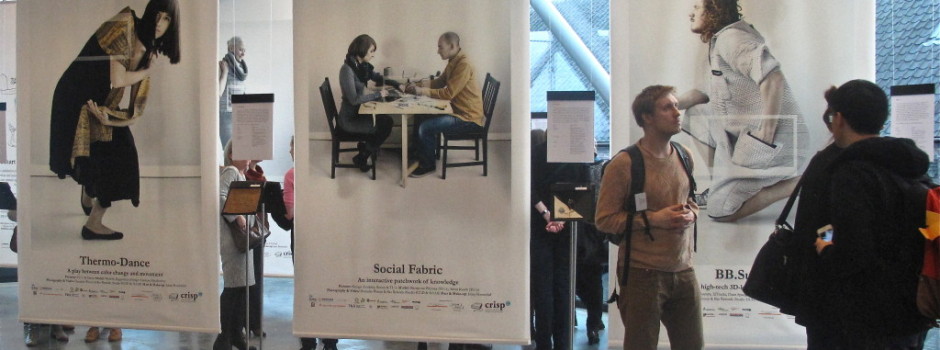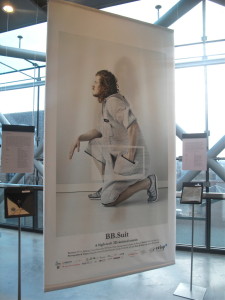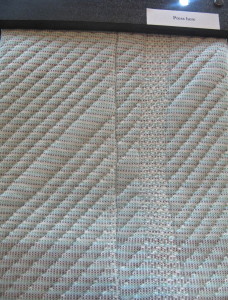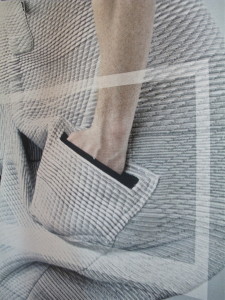
Dutch program seeks to support creative ventures and notes the service factor in bringing smart materials and applications to market.
The exhibition “Smart Textiles – Wearable Services” at the TextielMuseum, Tilburg, The Netherlands, highlighted the importance of including the provision of service in the development of smart materials, particularly for wearable applications. Although we have moved on from the idea that smart materials and systems are “answers looking for questions,” we are now facing the challenge of bringing these materials and their applications to market. Service is emerging as a key factor in this effort.
The work shown in the exhibition is drawn from the Smart Textile Services Project, an initiative from the Dutch Creative Industry Scientific Program (CRISP). The aim of CRISP is to establish a knowledge infrastructure to stimulate the creative industries. Within this, Smart Textile Services served as a testing ground for exploring cross-disciplinary partnerships that would include textile designers.
The list of partners is diverse and impressive, bringing together academic institutions such as Design Academy Eindhoven and TU Delft, manufacturers that include Lantor and Johan van de Acker Textielfabriek, alongside designer Pauline van Dongen.
The exhibition held in January-February 2015 showcased eleven prototypes emerging from the program. Large-scale photographic prints of the garments in use were accompanied by working models of the fabric prototypes that visitors could handle. Five of the material developments were produced in the museum’s own TextielLab.

Communication
Incorporating electronics into fabrics was a focus for the BB.Suit development. Designers Martin ten Bhomer, Borre Akkerdijk and Daan Spangenberg worked with partners TU Eindhoven, ByBorre, 22Tracks and Graphics & Want on the project. User experience is a key focus and, in particular, introducing novelty through the design and technologies.
Copper yarn that connects Wifi and GPS technologies is embedded in the knitted garment using 3D knitting. Pockets within the garment were used to store the chips for these communication systems, designed in such a way to allow for future modification as technologies advanced or new possibilities emerge on the market.
One of the challenges in smart materials is that advances in technologies do not happen in a convenient, linear way, but at irregular intervals. Designing for this at the outset adds to the longevity of the product as well as encouraging users, who might otherwise hang back waiting for the next iteration, to engage more readily. The overall design is defined by the graphics, use and accessibility.
The prototype was user-tested during the SXSW music and technology festival in Austin, Texas. Google Maps was used to broadcast the wearer’s location, with musicians invited to upload their tracks to a website that used the BB.Suit as a mobile URL.
Vigour is a garment designed for healthcare applications by designers Martijn ten Bhomer and Pauline van Dongen with partners TU Eindhoven and De Wever. It is intended as a means of communication between Alzheimer patients and their therapists to encourage greater interaction. The knitted, long-sleeved shirt uses a combination of stretch sensors and conductive yarn to gather patient data over the course of the day, which is communicated to the care-giver and the patient through sound or vibration.
Designs such as this are serving to illustrate the necessity of looking beyond visual data as the default means of communication. Smart materials and systems offer the possibility for many different types of communication because of their close proximity to the body.

Haptics
In the excitement of 3D printing, the focus is often fixed on making whole garments or objects using the process. There is a slow move towards combining the technique with other material and techniques and in this prototype the designers concentrate on the process of bringing together 3D printed components with textile elements in the garment.
Designer Marina Toeters has worked with partners Saxion, Matthijs Vertooren and by-wire.net to develop Print Dress. Three different connections have been developed:
1. A “slide-in” system that connects the various shoulder elements of the garment
2. A “weave-through” element that is used to link elements such as the waist belt.
3. The production process used to allow for the in-printing of buttons, which is the most complex. This entailed bringing in the textile to the 3D printing machine during the printing of the buttons. The combination of the two processes is a reminder of the user’s desire for different haptic qualities that 3D printing in isolation cannot yet provide.
Designer Eef Lubbers has worked with partners TU Eindhoven and Museum de Kantfabriek to develop Unlace, an interactive lace lingerie garment. Utilizing the traditional craft of bobbin lace making as both inspiration and technique, it has been developed as a smart material by the introduction of thermochromic inks and conductive thread. The result is a transformation of the material from black to light beige skin tones in response to touch. The heat of one partner’s hand translated to a visible response in the wearer’s lingerie.
The ability of lace to disguise and reveal has a long tradition that is here combined with technology. Haptic qualities and personalizing technology are both functions that craft introduces to the smart material design process.

New narratives
An automated narrative offers algorithms and natural language generators to create text with little—or potentially no—human intervention. Telling the story faces yet another technological challenge, but was also the focus of two prototypes in the exhibition that look at how we might bring both human communication and technology together.
Social Fabric is produced by designer Michelle Baggerman with partners Design Academy Eindhoven, Saxion, TU Eindhoven, V2, Waag Society and TextielMuseum. The concept behind the work is exploring how future users of smart textiles will have the opportunity to collaboratively write the story of the function and meaning of such materials to people and to society as a whole. The idea is drawn from contemporary craft practice where practitioners share and acknowledge the heritage and evolution of their work.
Augmented Reality is utilised in Textales by designers Kristi Kuusk and Studio Toer with partners TU Eindhoven, Unit040 and Johan van den Acker Textielfabriek. In Textales, interactive 3D objects appear on the woven fabric. By scanning the material with the application, flowers are revealed; by further manipulation, the objects are shown to move.
The digital is used to extend the capabilities of the woven textile to evolve over time and retain interest and novelty for the user. Craft values and sustainability lie at the heart of this concept, extending the life of the textile and opening new possibilities for the user to reconsider how to use and interact with smart materials.
In The Sixth Wave by James Bradfield Moody and Bianca Nogrady, the authors argue for a move away from manufacturing product to a more service-based business model. Their argument is motivated by environmental concerns, also of general interest in the development and application of smart textiles.
However, the importance of service to this field goes beyond sustainability and offers a strong design rationale for future development of smart materials for wearables. Smart Textile Services shows how this is possible and the necessity of collaboration across disciplines to achieve it.
Marie O’Mahony is professor of Materials Art + Design at the Design Faculty, Ontario College of Art + Design University; and visiting professor at University of the Arts, London.
 TEXTILES.ORG
TEXTILES.ORG


